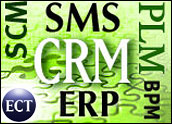
There’s a major disconnect between the expectations and results companies are getting when they realign processes aimed at serving their customers, as I’ve discovered in conversations with several manufacturers.
There are several reasons why these unrealistic expectations take hold. First, nearly every manufacturer that has complained about a lack of progress didn’t really have a solid handle on the problems with the process in the first place.
Take quote-to-order. Manufacturers who have not seen huge benefits from redesigning this process didn’t have a handle on the cost per order to begin with. In the rush to automate the process of creating quotes, they just sped up the mistakes the company was already making. Without proper metrics in place before the redesign, the company didn’t know where to start modifying the process.
Second, many manufacturers get swept up in the tidal wave of process-centric messaging, promises, and even case studies, but don’t ever define a roadmap for accomplishing the same result. Third, companies are failing more than ever before, despite guidance from vendors suggesting that best practices are the path to profitability.
What’s missing is an understanding that best practices is a benchmark instead of a roadmap that must be adhered to precisely. There are many more failures of process redesign than anyone would care to admit. Let’s take a look at how you can sidestep this problem by learning from other’s mistakes.
Culprit No. 1
Untrustworthy data kills every strategy it touches.
Ever since line-of-business managers climbed into the driver’s seat of IT spending, process-centric messaging spread faster than Google. Today these companies are disillusioned after spending in some cases over US$3.5 million in licenses and services for channel programs without having much to show for it.
When line-of-business managers started dictating how much was being spent and on what, everyone else couldn’t get enough of metrics, analytics and performance management. But in that rush to measure many companies measured the wrong things. As a result, they built quoting, channel management and order management strategies on the shifting sand of inaccurate data.
Culprit No. 2
Don’t buy the process-centric hype; any lasting result requires hard work.
For companies facing a crisis on the customer side of their businesses, there’s a strong tendency to buy first and ask questions later. The promises of quick returns from redefining processes is alluring to a company in trouble. What gets lost in the rush is the hard work of really understanding why, for example, quote-to-order is broken — and if the quoting process is even still needed in the order workflow.
Quickly layering on CRM, whether it is hosted or licensed or both, without first cleaning up the many processes that touch a channel or customer, is a recipe for disaster. The rationalization is that once the software is in, users will be weaned away from the manual process of entering orders, or that quotes and special pricing requests will be moved to the new system at the end of the quarter.
Too often the software is found to be less efficient than the manual process, because the root cause of the problems — error-filled order entry or incomplete customer records — never got addressed in the first place. Many companies find they do more orders but just get to error counts earlier in the quarter. That’s a dubious accomplishment for a $1 million-plus investment in license and services.
Culprit No. 3
Best practices is a benchmark, not a roadmap.
Claiming that all of this was driven by making a technology-centric purchase is a cop-out. What really happened is that these failed CRM, channel management and order management implementations are best-practices-gone-bad poster children.
No vendor will ever admit it, but a best practice for one vendor in a specific industry doesn’t come close to fitting the requirements of the customers’ competitor in the same industry. The fact that applications are now more modular gives vendors the chance to bring selective tools to the biggest pain points that manufacturers have. But that’s no excuse for selling a vision that best practices can be pumped out like Happy Meals when in fact each implementation requires the speed, strength and precision of a sushi chef.
Here’s a reality check: Best practices are far more valuable as a benchmark rather than as a roadmap. That has to be a core assumption about any strategy. One-size-fits-all best practices is an oxymoron.
A Process Roadmap
The following steps highlight what companies are doing to get the highest potential returns from redesigning their customer-facing, order management and quoting processes:
Which Processes Pay?
It’s troubling to find so many companies not really getting the results they expected after spending so heavily on customer-facing strategies. There are however processes that have proven themselves over years of research. These include the following:
Bottom line: Many CRM and sell-side implementations fail, and no one wants to ever admit this. That’s because these companies have bought into a best practices vision that isn’t accurate, because the processes that were broken to begin with have just been accelerated. Stop and look at the processes first and be selective about applying software to your biggest CRM and customer-facing pain points.
Louis Columbus, a CRM Buyer columnist, is a former senior analyst with AMR Research. He currently works in the software industry.
















































